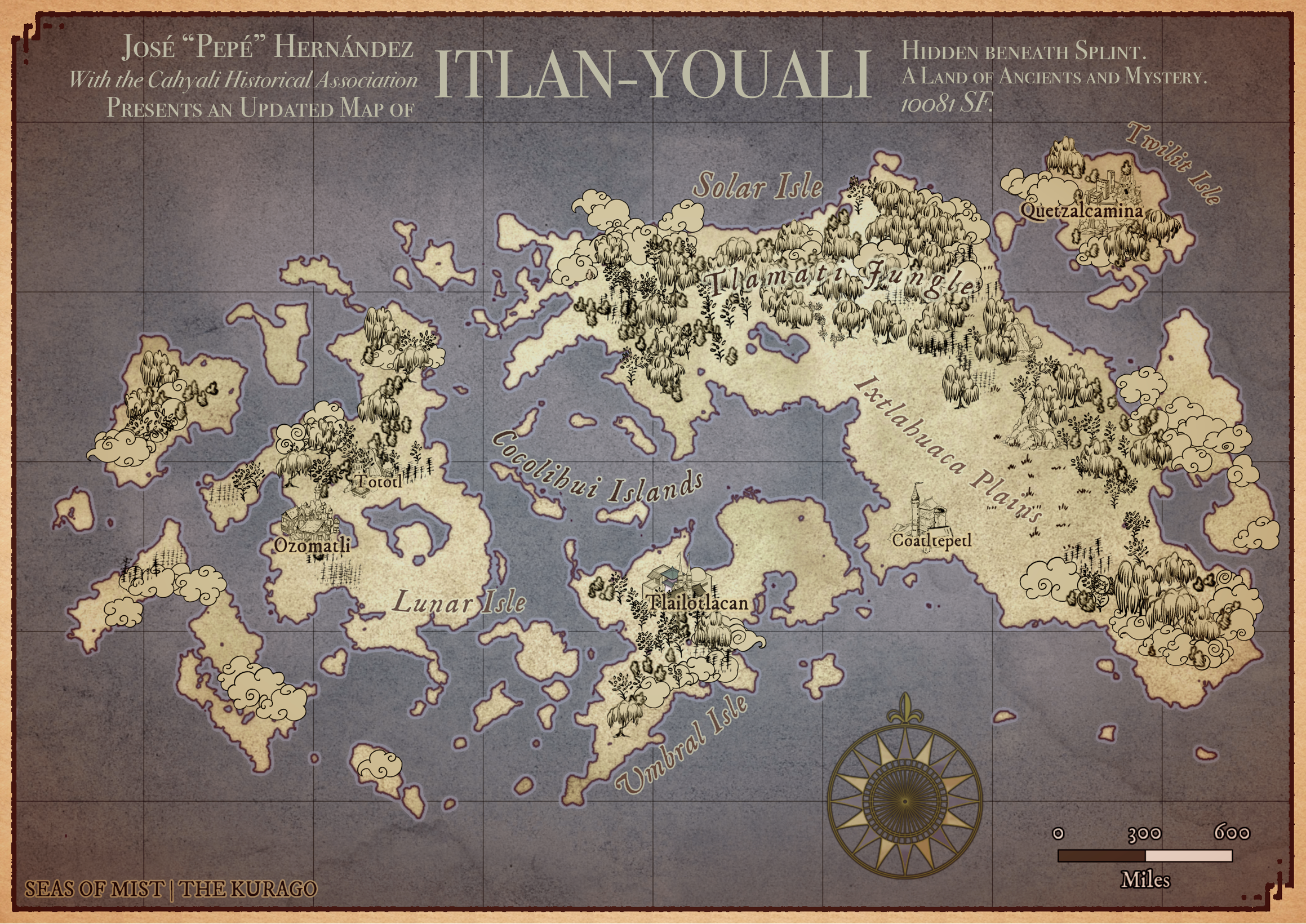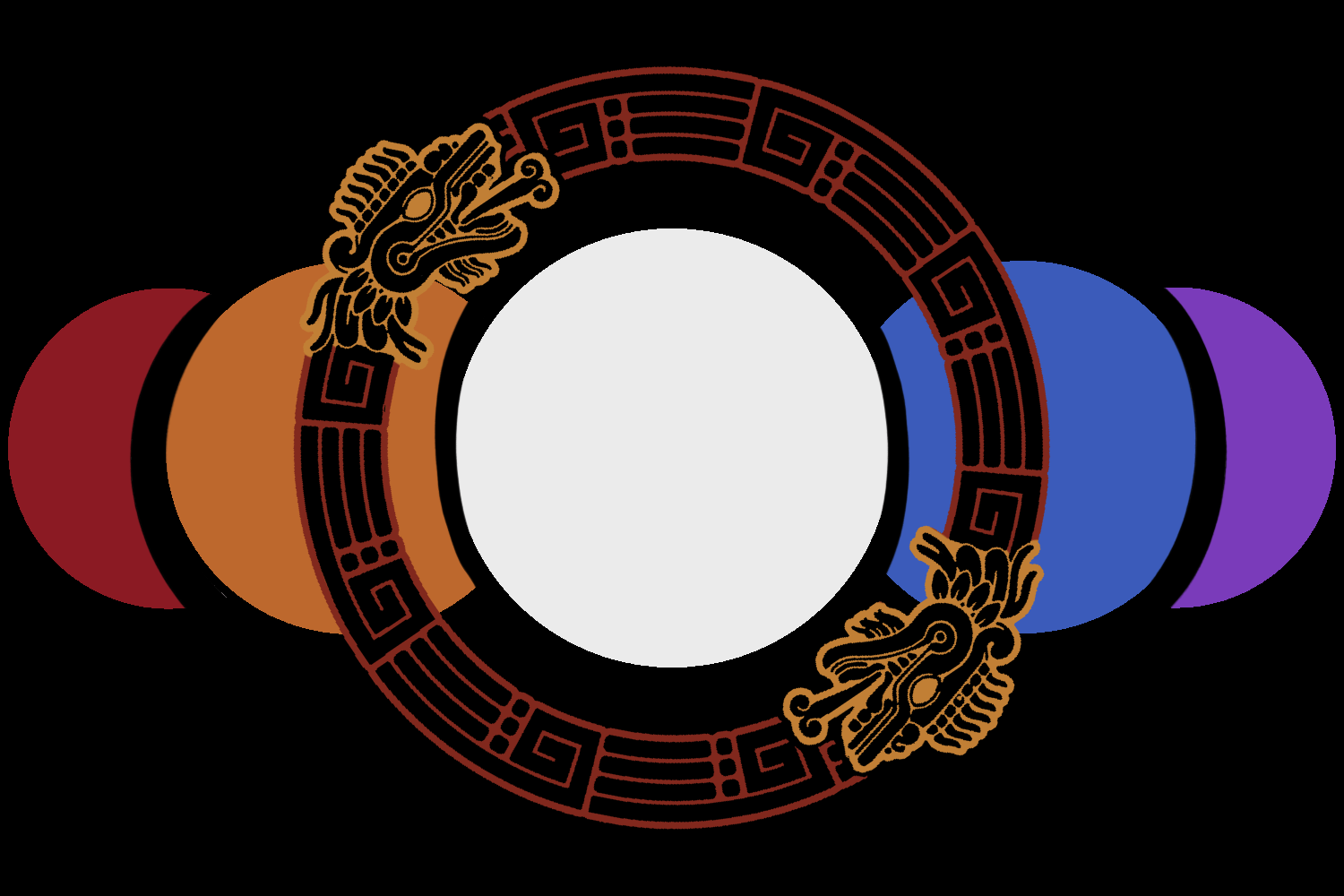Table of Contents
Itlan-Youali
- Government Type: Monarchic Diarchy
- Symbol: Ouroboros & Five Suns
- Major Races: Elementals, Humans, Lizards
- Capital: Ozomatli, Quetzalcamina
- Demonym: Tonatiu; Tlaca (informal)
Overview
Scattered across Splint are pools within sinkholes, known as cenotes. At the right time, and with a little luck, leaping into one of these cenotes will lead one to the vast underground realm of Itlan-Youali. One might expect these caverns to be desolate and dark, like most caves, but Itlan-Youali is anything but. Veins of gold-obsidian carved into intricate shapes deliver light below like several small suns, supporting a lush tropical landscape. The islands of Itlan-Youali float, magically suspended in a thick mist. Some believe that this mist leads to the Kurago, or perhaps the Dreaming. Accounts from those that have descended and survived are discombobulated and confused. The inhabitants of Itlan-Youali are the Tonameyoti Atlaca people, also known as the Tonatiu or, informally, the Tlaca.
Within these dense forests live the mystical alebrijes, as well as multitudes of small dinosaur species. Most impressive, though, are the cities rising above the trees. Itlan-Youali has two capitals, each equal in dignity and power. Despite being aware of the surface world and overall receptive to the occasional visitor from above, Itlan-Youali remains staunchly neutral in world conflicts, refusing to assist Splint in its plight or take a side in any war. Itlan-Youali is based on the Aztec culture.
Natural Resources
Gold-Obsidian is a unique form of obsidian found within the ceilings of Itlan-Youali. Gold Obsidian typically forms in veins of glass crystals that travel all the way from the sun in Splint down to the caverns of Itlan-Youali. When exposed to sunlight, the obsidian will shine a golden hue and give off its own light, actually absorbing the sun's energy. When exposed to moonlight, the obsidian will instead shine silvery white, though it cannot actually absorb energy from the moon. This energy can then be tapped into by individuals attuned to specific crystals, though crystals will ambiently let off sun energy if it is not specifically attuned.
Dinosaurs are one of the more common fauna in the caverns. Most species extant in Itlan-Youali are raptors, no bigger than a wolf. A few larger herbivorous species exist as well, mostly armored sorts such as stegosaurus and ankylosaurus. Most have colorful feathers or beautiful armor plates, and a few of these raptor species have been domesticated by the Tonatiu as hunting and sporting animals, for meat, or as pets.
Governance
Despite its relatively small size, Itlan-Youali has two capitals: Ozomatli, the Dusk Capital, and Quetzalcamina, the Dawn Capital. As a diarchy, two rulers are chosen: one in each capital city, usually appointed by “divine right” and decided by the priesthoods. Most of these decisions hinge on declarations of past life; each ruler of Itlan-Youali is, supposedly, the reincarnation over many lifetimes of the cities' original rulers. Below the monarchs are the high priests, following a deity known as Tlayahucoatl. Religion guides much of the daily lives of the Tonatiu.
Itlan-Youali policy has always been aggressively isolationist, refusing to take direct involvement in foreign affairs, especially considering the tumultuous conditions above. This is driven mostly by a fear of invasion. The Tonatiu have evaded destruction many times, and are not open to risking this again. Those who disregard this policy and expose Itlan-Youali to outside threats are considered traitors. Some evade this punishment, escaping to the surface. Many of these escapees have formed the Dominion Del Sol.
Also holding immense political sway in Itlan-Youali is the Crystalsmiths’ Guild, responsible for constant maintenance of the gold-obsidian that refracts and delivers light to the underground realms, allowing for the growth of crops. Laws and punishments in Itlan-Youali include:
- Theft, of personal or public property: Fine equal to double the stolen item’s worth
- Tampering with gold-obsidian constructs: Incarceration for 1-5 years
- Assault: Incarceration for 4-7 years and an additional consequence chosen by the victim
- Murder or rape: Incarceration for at least 15 years, or execution depending on degree
- Heretical religious ritual, including open worship of demons, fey entities, or eldritch beings: Exile
- Ownership of another intelligent humanoid being: Execution
- Treason: Execution
For more information on the history and culture of Itlan-Youali, follow this link: Splint & Itlan-Youali History & Overview
The national flag of Itlan-Youali. It is often displayed vertically.
Cities of Itlan-Youali
Ozomatli, the Dusk Capital: When Itlan-Youali was first discovered millennia ago, Ozomatli was the first capital built as the underground realms began to grow in population and sophistication. Across time, this massive metropolis has stood as a testament to the Tonatiu and their ways.
Quetzalcamina, the Dawn Capital: This city once existed on the surface, fulfilling a duty as the surface capital of Tonameyoti Atlaca during ancient days. When the Dahabi invaded, a massive amount of effort was put in to sink this city into Itlan-Youali, where it remains to this day - safe and protected from outsiders' violence.
Tlailotlacan: This city is the enclave of elemental mages in Itlan-Youali. While many are still faithful to the gods, they believe cultivating their own magical abilities is a way to honor their gift of life in the world. To those of Tlailotlacan, pursuing a path of sorcery is heretical. This city boasts many stunning arcane sights, from floating ziggurats to ballgames played entirely in the air, bolstered by dangerous blasts of magic.
Coatltepetl: Located far from society in the middle of the Ixtlahuaca Plains, this settlement is a prison town. Most of its population is made up of inmates, with the rest being guards and their families. Here, executions are sometimes performed by casting one down into the endless mist below.
Tototl: This town is close to Ozomatli, situated near a lively waterfall. It is known as a hub of trade and technology, and certain Tototl craftsmen have been pushing for more contact with the outside world, believing that a more open exchange of ideas has the potential to bring Tonatiu society to new heights.
Culture
Having escaped underground and avoided the bloody history of Splint, Itlan-Youali has lived mostly undisturbed for millennia upon millennia. With limited space, their society has had little room to grow, but neither is infinite growth an objective of Tonatiu culture. As one of the few nations that escaped Dahabi dominion, Tonatiu religion is quite different than the usual.
While they acknowledge the other gods’ existence and give each of them a requisite place in their society, the main gods they worship are Peregrinus, Tenebrus, Anpu, Aset, and Seherine, who they see as a single deity with a domain of cycles: Tlayahucoatl and Thoth, Vormaxia, and Arakh in the form of the goddess of civilization: Ichtaca. Itlan-Youali is one of the few places where Tenebrians exist, and are known without being chased out of polite society. Some religious rituals involve sacrifice of a willing participant, with the promise that the cycle of reincarnation will carry them into a new life. Sacrifice of an unwilling Tonatiu citizen is considered high heresy by the ruling priests.
The Tonatiu greatly value history and the perseverance of past knowledge, with vast libraries in their larger cities dedicated to archival of the years. They also put value on coexistence with nature, believing in the existence of reincarnation. The dead in Itlan-Youali are buried without embalming in Anpuan temples, left for nature to reclaim as part of the world’s great cycle. Hibiscus plants are often grown over these graves, later harvested to brew tea. In coming of age ceremonies, it is traditional to drink tea made with the hibiscus flower of one’s previous life to represent the cycle of life and death continuing in a new body.
Tonatiu aesthetics are quite geometric, with large chunky elements on their clothing and accessories, as well as feathers incorporated into ceremonial dress. Their art is large, bold, and iconic, taking the form of large carvings and murals. A popular sport in Itlan-Youali is a game called ullamalitzli, played on a stone court with the objective of shooting a ball through a high-up goal post.
The Tonatiu also keep populations of various tame dinosaurs as livestock and companion animals, mostly consisting of raptors. These range from dog-sized velociraptors, to larger beasts used as transportation. Alebrijes are far less common, but not unheard of housepets as well.
Religion
Religious life is a massive part of Tonatiu society. Though some of the other Jaernian gods see worship here under other names, the primary deity venerated is Tlayahucoatl, god of cycles. According to ancient Zinaparan and Tonatiu legends, Tlayahucoatl is the being that commands the string of fate itself and keeps the world in constant motion. They are represented by a two headed snake moving in a circle as if dancing with itself. Anything that fits within the nature of cycles falls under the domain of Tlayahucoatl, including the dawn and dusk, life and death, and fate itself. In the modern age, worship of Tlayahucoatl has diminished greatly in Splint and is only really observed by natives of Zinaparo. However, the faith is still incredibly strong and influential in Itlan-Youali.
A key part of belief in Tlayahucoatl is reincarnation: that the soul endures even if the body dies, and that the body is second to the soul in importance. When a soul is reborn in a new body, upon reaching the age of maturity of their race a priest of the Domain of Life and a priest of the Domain of Death will lead the individual to where their previous body was buried, asking for them to drink hibiscus water made from the nutrients of their previous body, completing the cycle.
The Finding of the Spark is a ceremony that is done close to childbirth that is tied very closely to the Cycle of Reincarnation. In this, a priest of the Domain of Life, Death, and Fate all convene and examine children who had been recently born, looking for the spark of who they once were in their eyes. Once a child is found in this way, they are given the name of their previous life. If a child has no spark, then they are considered a Yankiuk Soul or a new soul. Once the Spark is found, a child is named after their previous life. A single soul is believed to chase the same goals and have the same natural talents over their many lifetimes.
Tonatiu have rather open views around individuality and identity, as the body is second to the soul. If there is a disconnect between the soul and the body, then the body must be changed to accommodate the soul within it, and in finding a partner, the soul of the person you love is more important to their appearance. Because of this, people in Itlan-Youali are much quicker to judge someone on their merits and personality over their appearances.


